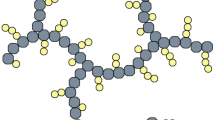Abstract
Synthetic polymeric flocculants are used extensively for wastewater remediation, soil stabilization, and reduction in water leakage from unlined canals. Sources of highly active, inexpensive, renewable flocculants are needed to replace synthetic flocculants. High kaolin flocculant activity was documented for bovine blood (BB) and blood plasma with several anticoagulant treatments. BB serum also had high flocculant activity. To address the hypothesis that some blood proteins have strong flocculating activity, the BB proteins were separated by SEC. Then, the major proteins of the flocculant-active fractions were separated by SDS-PAGE. Identity of the major protein components was determined by tryptic digestion and peptide analysis by MALDI TOF MS. The sequence of selected peptides was confirmed using TOF/TOF-MS/MS fragmentation. Hemoglobin dimer (subunits α and β) was identified as the major protein component of the active fraction in BB; its high flocculation activity was confirmed by testing a commercial sample of hemoglobin. In the same manner, three proteins from blood plasma (fibrinogen, γ-globulin, α-2-macroglobulin) were found to be highly active flocculants, but bovine serum albumin, α-globulin, and β-globulin were not flocculants. On a mass basis, hemoglobin, γ-globulin, α-2-macroglobulin were as effective as anionic polyacrylamide (PAM), a widely used synthetic flocculant. The blood proteins acted faster than PAM, and unlike PAM, the blood proteins flocculants did not require calcium salts for their activity.




Similar content being viewed by others
References
Maximova, N., & Dahl, O. (2006). Environmental implications of aggregation phenomena: current understanding. Current Opinion in Colloid & Interface Science, 11, 246–266.
Kholkin, Y. I., Viglazov, V. V., Kind, V. B., & Mettee, H. D. (1999). Purification of carbohydrate-containing substrates from plant biomass hydrolysates. Applied Biochemistry and Biotechnology, 82, 135–140.
Richardson, P. F., & Connelly, L. J. (1988). Chapter 17, Industrial coagulants and flocculants. In P. Somasvndaran & B. M. Moodgil (Eds.), Surfactant Science Series, Vol. 2, Reagents in Mineral Technology (pp. 519–557). New York: Marcel Dekker.
Salehizadeh, H., & Shojaosadati, S. A. (2001). Extracellular biopolymeric flocculants, recent trends and biotechnological importance. Biotechnology Advances, 19, 371–385.
Ghimici, L., & Nichifor, M. (2010). Novel biodegradable flocculanting agents based on cationic amphiphilic polysaccharides. Bioresource Technology, 101, 8549–8554.
Ho, Y. C., Norli, I., Alkarkhi, A. F. M., & Morad, N. (2010). Characterization of biopolymeric flocculant (pectin) and organic synthetic flocculant (PAM): a comparative study on treatment and optimization in kaolin suspension. Bioresource Technology, 101, 1166–1174.
Renault, F., Sancey, B., Badot, P.-M., & Crini, G. (2009). Chitosan coagulation/flocculation processes—an eco-friendly approach. European Polymer Journal, 45, 1337–1348.
Patil, S. V., Patil, C. D., Salunke, B. K., Salunkhe, R. B., Bathe, G. A., & Patil, D. M. (2011). Studies on characterization of bioflocculant exopolysaccharide of Azotobacter indicus and its potential for wastewater treatment. Applied Biochemistry and Biotechnology, 163, 463–473.
Zhang, Z., Xia, J., Zhao, S., & Zhang, J. (2010). Characterization and flocculation mechanism of high efficiency microbial flocculant TJ-F1 from Proteus mirabilis. Colloids and Surfaces. B, Biointerfaces, 75, 247–251.
Kragh, A. M., & Langson, W. B. (1962). The flocculation of quartz and other suspensions with gelatin. Journal of Colloid Science, 17, 101–123.
Gassemschmidt, U., Jany, K. D., Tauscher, B., & Niebergall, H. (1995). Isolation and characterization of a flocculating protein from Moringa oleifera Lam. Biochimica et Biophysica Acta, 1243, 477–481.
Seki, H., Maruyama, H., & Shoji, Y. (2010). Flocculation of diatomite by a soy protein-based bioflocculant. Biochemical Engineering Journal, 51, 14–18.
Piazza, G. J., & Garcia, R. A. (2010). Meat and bone meal extract and gelatin as renewable flocculants. Bioresource Technology, 101, 781–787.
Piazza, G. J., & Garcia, R. A. (2010). Proteins and peptides as renewable flocculants. Bioresource Technology, 101, 5759–5766.
Wang, X., Zhang, S., Zhou, L., & Ren, L. (2011). The hydrolysis of gelatin and its treatment of waste drilling fluid. Advanced Materials Research, 281, 141–146.
Del Hoya, P., Moure, F., Rendueles, M., & Diaz, M. (2007). Demineralization of animal blood plasma by ion exchange and ultrafiltration. Meat Science, 76, 402–410.
Piazza, G. J., McAloon, A. J., & Garcia, R. A. (2011). A renewable flocculant from a poultry slaughterhouse waste and preliminary estimate of production costs. Resources, Conservation and Recycling, 55, 843–848.
Levy, N., Magdassi, S., & Bar-Or, Y. (1992). Physico-chemical aspects in flocculation of bentonite suspensions by a cyanobacterial bioflocculant. Water Research, 26, 249–254.
Bratby, J. (2006). Treatment with polymers. In: Water and wastewater treatment, 2nd ed. (pp. 186–218). London: IWA Publishing.
Dimino, M. L., & Palmer, A. F. (2007). Purification of bovine hemoglobin via fast performance liquid chromatography. Journal of Chromatography. B, Analytical Technologies in the Biomedical and Life Sciences, 856, 353–357.
In, M.-J., Chae, H. J., & Nam-Soon, O. (2002). Process development for heme-enriched peptide by enzymatic hydrolysis of hemoglobin. Bioresource Technology, 84, 63–68.
Duarte, R. T., Carvalho Simões, M. C., & Sgarbieri, V. C. (1999). Bovine blood components: fractionation, composition, and nutritive value. Journal of Agricultural and Food Chemistry, 47, 231–236.
Ockerman, H. W., & Hansen, C. L. (2000). Chapter 9, blood utilization. In: Animal by-product processing & utilization (pp. 325–354). Lancaster: Technomic Publishing Company, Inc..
Chang, Y.-K., Chou, S.-Y., Liu, J.-L., & Tasi, J.-C. (2007). Characterization of BSA adsorption on mixed mode adsorbent. I. Equilibrium study in a well-agitated contactor. Biochemical Engineering Journal, 35, 56–65.
Perkins, D. N., Pappin, D. J. C., Creasy, D. M., & Cottrell, J. S. (1999). Probability-based protein identification by searching sequence database using mass spectrometry data. Electrophoresis, 20, 3551–3567.
Acknowledgment
Technical assistance was provided by F. Fox and R. Latona.
Author information
Authors and Affiliations
Corresponding author
Additional information
Mention of trade names or commercial products in this publication is solely for the purpose of providing specific information and does not imply recommendation or endorsement by the U.S. Department of Agriculture.
Rights and permissions
About this article
Cite this article
Piazza, G.J., Nuñez, A. & Garcia, R.A. Identification of Highly Active Flocculant Proteins in Bovine Blood. Appl Biochem Biotechnol 166, 1203–1214 (2012). https://doi.org/10.1007/s12010-011-9505-7
Received:
Accepted:
Published:
Issue Date:
DOI: https://doi.org/10.1007/s12010-011-9505-7




